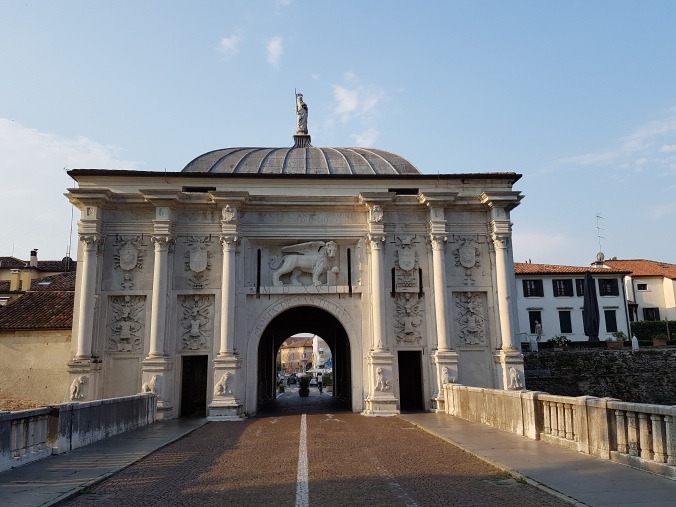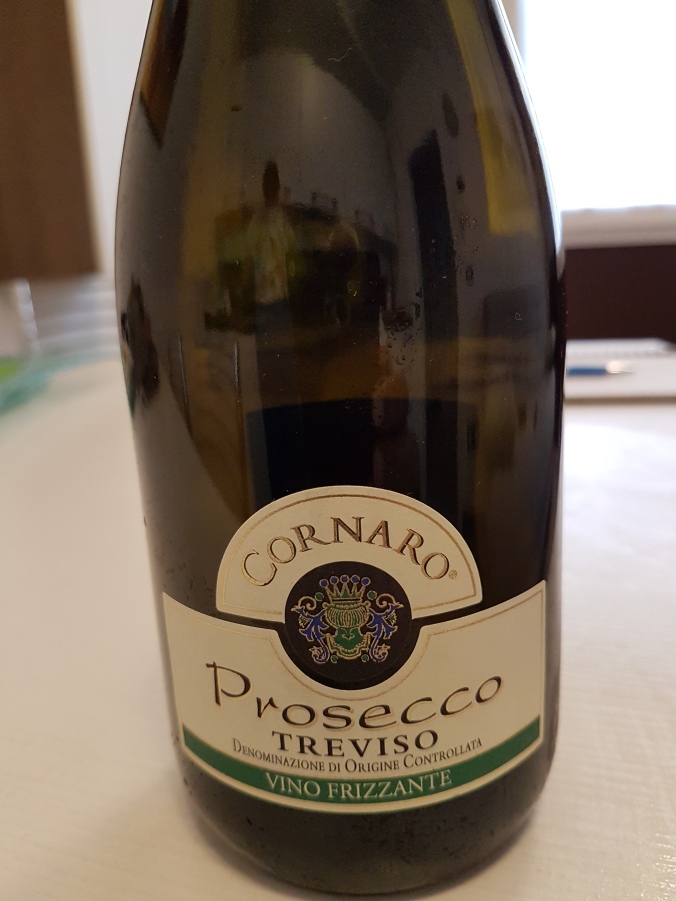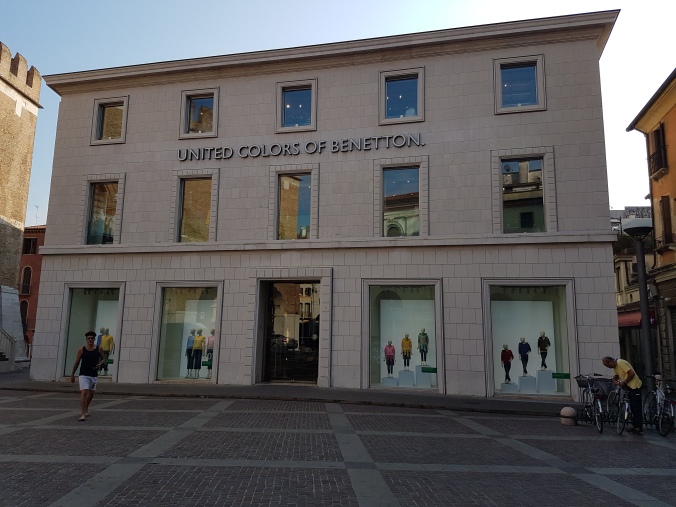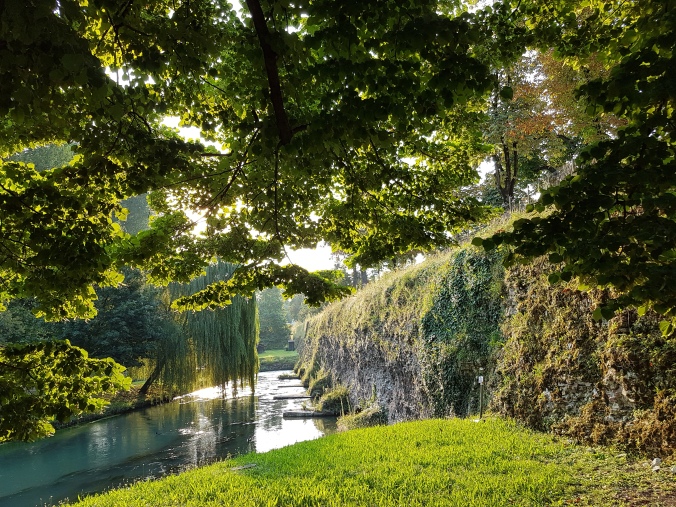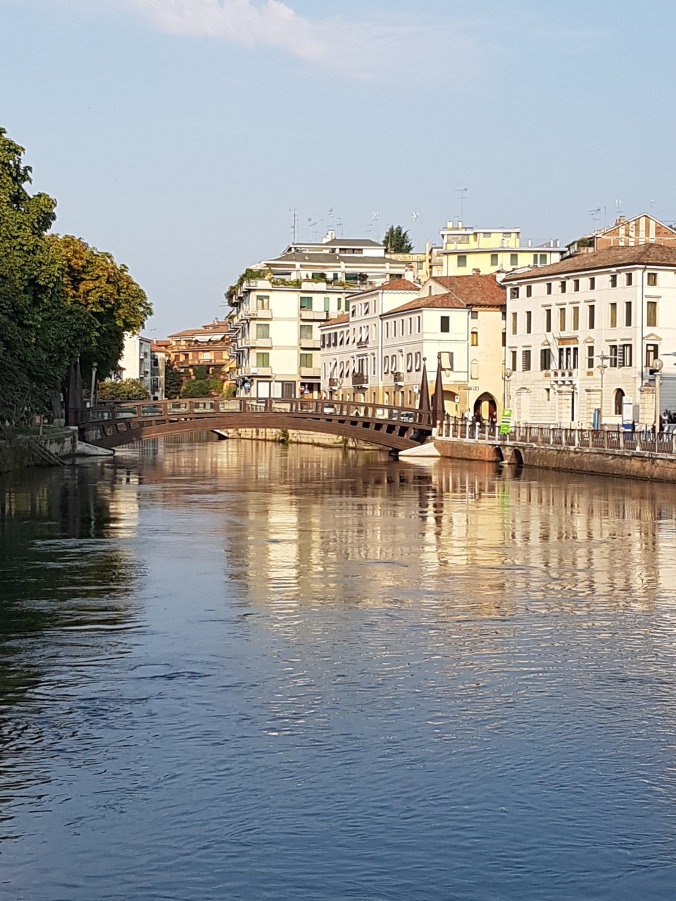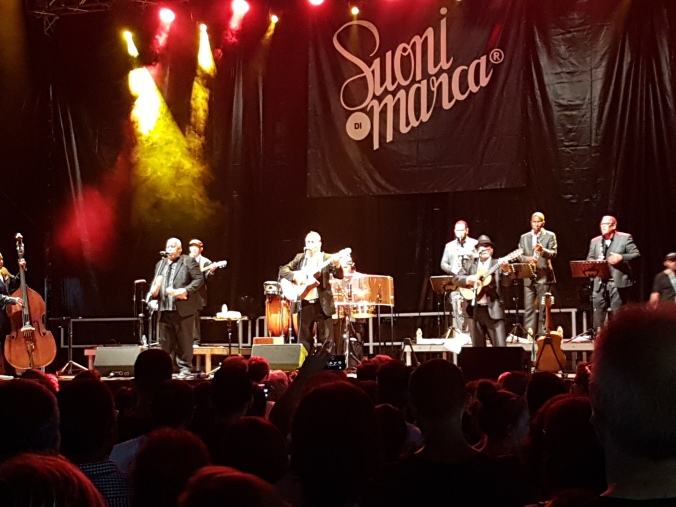The grand Vittorio Emmanuele building stood in front of us with the magnificent Duomo to our right. Our excitement to see more of Milan through the eyes of a local was not dampened by the blistering summer sun beating down on us while we waited. After thirty minutes though we realised the host of the walking tour was not going to appear. It looked like he had joined the other Milanese to abandon the city for the summer holidays! Our other walking tour buddies were just as disappointed as we separated in different directions to fend for ourselves.
See more of Milan with a Stroll Buddy
Fast forward to our next visit. We discovered the Stroll Buddy group (formerly Global Greeter Network) and booked a day with a Greeter before leaving on our six-week road trip. Dino and his apprentice, Sandro met us outside our apartment at precisely 9:30 am.
San Bernandino alle Ossa
Our first stop was not far from our apartment in the city centre. Dino guided us into the side chapel of the church with walls embellished with human skulls and bones. Macabre but artistic too. The bizarre idea to decorate a chapel with human remains dates back to the Middle Ages. Space was running out in the courtyard cemetery where the church now stands so it was decided to excavate the remains and store them. A church was built with a dedicated chapel for the remains to be displayed.
The artistic creations will capture your attention but remember to look up to see the amazing frescoes on the ceiling. Sandro was astonished as us. He hadn’t seen the chapel in all his years living in the city!

Milan University
There’s one thing we’ve discovered on our travels. Universities are full of hidden treasures and Milan University is no exception
We started our visit with a stroll along the outer walls while Dino provided some background history. His commentary didn’t prepare us for the stunning main courtyard just inside the entrance.

The grounds of the University are unique because two courtyards further inside the University precinct hold Roman ruins: a Roman fridge for storing perishables and medicines and a large kitchen with a courtyard where wood was stored and fires lit for cooking.


The University was a hospital in its past life and there were remnants of the past visible as we walked through the university. The old hospital ward now converted into a law library left a lasting impression as we walked through to see more of the University’s stunning architecture.
San Satiro Church
Retracing our steps to the main city area, Dino pointed out San Satiro church (Santa Maria presso San Satiro) urging us to make a visit the next day when it was open. Since we were staying in the area we returned to find the nondescript facade of the building is deceptive! We’ll not give away any secrets but we strongly recommend making time in your itinerary to visit. And, look out for the illusory apse when you visit.

The L.O.V.E. sculpture
A large marble sculpture named L.O.V.E stands in front of the Stock Exchange building in Piazza degli Affari. According to Dino, the Milanese call it “The Finger”. Commissioned in 2008, the sculpture is known to be a statement against the fascist rule and sends a message to the financial sector which contributed to the Italian financial crisis. There is a twist to the meaning of the name. L.O.V.E stands for liberta, odio, vendetta, and eternita (freedom, hate, revenge, and eternity). How did we miss it on past visits?

Castello Sforzesco

One of Milan’s most famous landmarks is the Castel. We had strolled around the fortress and gardens before, however this visit was much more informative. Dino invited us to look closer at the detail on the walls and things we had not paid attention to on past visits.

Beyond the castle are shaded gardens with paths to wander along to reach the Porta Napolean at the far end. Napolean, of course, wanted to make a grand entrance whenever he visited the city!
Dino shared stories and more history of his city as we navigated the circumference outside the castle walls. By this time we were all ready for a coffee break. Princi is one of Milan’s popular coffee houses and artisanal bakeries, and would you believe it, there was one just across the road. It was a hot day so a cold coffee, shaken, stirred and served in a martini glass was enjoyed by all before Sandro took his leave. He was expected home to have lunch with his father.
Brera
One of Milan’s most chic districts is Brera. It’s home to some of Milan’s best fashion boutiques along with numerous dining venues. The district’s past has left it with a bohemian touch. However, we were not there to shop or eat but to experience the arts.

Housed in an old convent, Dino took us into the Academia di Belle Arti di Brera (Academy of Fine Arts). The Academy shares its space with the Pinacoteca, an exhibition space housing the works of some of Italy’s greatest artists including Bellini, Raphael and Caravaggio. A leisurely walk through both provided the opportunity to view more famous exhibits along with the artworks of current and past students. Not to mention, a chance to appreciate the building’s magnificent architecture.
The highlight: Climbing a staircase to enter the Biblioteca Braidense, one of Italy’s largest and most beautiful national libraries. The walls are lined with books, dating back to the 1600s displayed in glass cabinets. We were lost for words!

The Botanical Gardens are also in Brera. While we didn’t have an opportunity to visit at the time we will be returning to explore on our next visit.
Fashion in Moscova
The city’s reputation as one of the world’s fashion capitals is apparent throughout the city through the men, women and children who proudly wear Italy’s great fashion labels. And, Moscova is the district to go to for fashion, with small boutiques and fashion houses enticing visitors to shop.
Behind a nondescript frontage and through a courtyard bistro is the Moscova District Market. It’s a large space displaying collections well-known Italian brands and their latest collections. Today entry is limited and by reservation only. We recommend reserving to have a look inside if you have the time. You might even be tempted to take home a unique piece of clothing or accessory as a memento of your visit to Milan.

Eataly stores are now located in many of the world’s major cities. If you haven’t visited one before and you’re a lover of Italian food and fare, you’ll enjoy wandering through the store located in Moscova. Stop for a bite to eat before you carry on to New Milan.
Porta Nuova
Porta Nova is everything a visitor to Milan will not expect and a contrast to the older districts we walked through. Some of the older rundown areas have been transformed into green spaces and walkways and futuristic office towers built. This is the city’s financial and business district.
Dino led us along a pathway from the piazza to Bosco Verticale (Vertical Wood) The apartment complex was nominated as the most innovative high-rise in the world in 2014. Since then, it has inspired similar concepts in high-rise building architecture worldwide. Dino provided an insight into the area’s development and past history. It allowed us to appreciate it more than we would have if we had come to see it on our own.

A young couple stopped to hear Dino’s commentary asking him what other highlights in Milan they should visit. Without hesitation, Dino provided them with a list of the places we had visited during the morning. Yet we knew from our time with Dino though, that they will not grasp what they are looking at. It is the small things that only a local knows that has enhanced our visit to this wonderful city.
Dino bids us farewell here. He politely declined our offer to take him to lunch. His wife was waiting for him at home with his lunch ready. He reluctantly accepted the small token of appreciation that we have brought, citing that it wasn’t necessary and that he would love to show us more at another time. With a wave, he left us to retrace our footsteps back to the city centre.
Our conclusion – did we see more of Milan?
Having been to Milan before, independently and with a tour group we agreed our time with Dino was very well spent. We could have looked up these sites and researched our hearts out but the insights and stories that Dino and Sandro provided into their city proved invaluable. There is no doubt that we will be seeing more of their city with them on a future visit.
In case you are interested…
Where we stayed
On a previous visit we had found an apartment offered by Hemeras Boutique Homes through Booking.com. They had a number of apartments throughout the city. Our apartment was two streets from the Cathedral and because of its proximity to all the main attractions, we were keen to return. We contacted them directly to enquire if they had the same apartment available. Unfortunately it was not, offering us another apartment in the same complex at a discount which we gladly accepted.
Where we ate
The precinct around via Paola da Cannobio where we stayed had numerous local eateries to choose from. After a day of wandering around the city it was pleasant to spend a relaxed summer evening dining where the locals enjoyed their evening meals.
Where we shopped
Milan is a fashion capital and if you’re wanting to take home a fashion piece , we’ll let you in on a secret place to shop. Elegant Galleria Vittorio Emmanuelle offers designer and exclusive boutique shopping and the stores around the Duomo offer a choice of high street fashion. However, if you’ve got time and would like an Italian creation, walk the short distance to and along Corso Venezia. Here you’ll find our favourite outlet store, Matias. It’s a treasure trove of men’s and women’s fashion at reasonable prices.
Want to do something outside of the city?
Take a day trip to Lake Como one hour north of Milan. It’s easily accessible by rail, bus or car. If you have a car, you can take a slow drive winding your way around the lake where you’ll pass by beautiful lakefront villages to vibrant Bellagio. If you arrive in Como by bus or rail, indulge in hopping from town to town on the ferries which regularly criss-cross across the Lake.
Want to see more of Italy?
Read about some of our finds:
- Things you’ll love to see and do in charming Genoa
- When is the best time of the year to visit Tuscany
- See the hidden treasures just outside of Rome
Need more info or suggestions on what to do in Milan and beyond?
Feel free to ask away in the comments below or email us at info@travellingsimply.com.
.






























